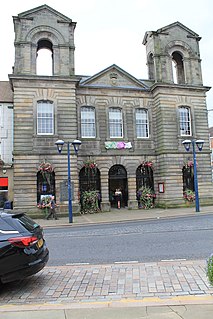
Gravesend is a town in northwest Kent, England, situated 21 miles (35 km) east-southeast of Charing Cross on the south bank of the River Thames and opposite Tilbury in Essex. Located in the diocese of Rochester, it is the administrative centre of the Borough of Gravesham.

The Borough of Dartford is a local government district in the north-west of the county of Kent, England. Its council is based in the town of Dartford. It is part of the contiguous London urban area. It borders the borough of Gravesham to the east, Sevenoaks District to the south, the London Borough of Bexley to the west, and the Thurrock unitary authority in Essex to the north, across the River Thames. The borough was formed on 1 April 1974 by the merger of the Municipal Borough of Dartford, the Swanscombe Urban District, and part of the Dartford Rural District. According to the 2011 Census, its population was 97,365.

Gravesham is a local government district with borough status in north-west Kent, England. Its administrative centre and largest town is Gravesend, which was known as Gravesham in ancient times.

Cobham is a village and civil parish in the borough of Gravesham in Kent, England. The village is located 6 miles (10 km) south-east of Gravesend, and just south of Watling Street, the Roman road from Dover to London. The parish, which includes the hamlet of Sole Street, covers an area of 1,240 hectares and had a population of 1,469 at the 2011 Census, increasing from 1,328 at the 2001 Census.

Shorne is a village and civil parish in the borough of Gravesham in Kent, England. The parish lies 3 miles (4.8 km) east of Gravesend. Most of the land is well-drained but its marshes, the Shorne Marshes reach down to the Thames Estuary and are an SSSI amid the North Kent Marshes on the Hoo Peninsula proper.

Meopham is a large linear village and civil parish in the Borough of Gravesham in Kent, England, lying to the south of Gravesend. The parish covers 6.5 square miles (17 km2), and comprises two villages and two smaller settlements; it has a population of 6,427 increasing slightly to 6,722 at the 2011 census. Meopham village is sometimes described as the longest settlement in England although others such as Brinkworth, Wiltshire make the same claim. Meopham is one of the longest linear settlements in Europe, being 7 miles (11 km) in length.

Milton-next-Gravesend is an ecclesiastical parish in the north-west of Kent, England, which is now part of the Gravesend built-up area.

Chalk is a village and since 1935 a former civil parish which adjoins the east of Gravesend, Kent, England. As is intuitive, its name comes from the Saxon word cealc meaning a chalkstone. In 1931 the parish had a population of 563.

The Gravesend–Tilbury Ferry is a passenger ferry across the River Thames east of London. It is the last public crossing point before the Thames reaches the sea.

Singlewell or Ifield is the name given to the area south of Gravesend in Kent, England.

St George's Church, Gravesend, is a Grade II*-listed Anglican church dedicated to Saint George the patriarch of England, which is situated near the foot of Gravesend High Street in the Borough of Gravesham. It serves as Gravesend's parish church and is located in the diocese of Rochester in Kent, England.

The Bat & Ball Ground is a cricket and sports ground in Gravesend in Kent. The ground was used as a first-class cricket venue by Kent County Cricket Club between 1849 and 1971. It remains in use by Gravesend Cricket Club who have used the ground as their home since their formation in 1881. The site also has lawn bowls and tennis facilities and is the home of Gravesend Bowls Club.

The Gravesend Town Pier is located in Gravesend, Kent. It was designed by William Tierney Clark and built in 1834 on the site of the earlier Town Quay. Over 3 million passengers were served between 1835 and 1842, but around 1900, this pier fell into disuse due to the arrival of the railways.

Shorne Wood Country Park is located between Strood and Gravesend, in the English county of Kent. It was once part of a large estate, later passed to the county council to be used as a country park.
Toltingtrough was a hundred in the Lathe of Aylesford in the county of Kent, England. This hundred is called, in some ancient writings, Toltetern and Tollentr, and in Domesday, Tollentru. In the return made of the several knights fees throughout England, by inquisition into the exchequer, in the 7th year of king Edward I, the archbishop of Canterbury appears to have been then lord of this Hundred.

Newark Town Hall is a municipal building consisting of a town hall, assembly rooms and a market hall in Newark on Trent, Nottinghamshire, England. It is a Grade I listed building.

Maidstone Town Hall is a municipal building in Middle Row, Maidstone, Kent, England. The town hall, which is a meeting place of Maidstone Borough Council, is a Grade II* listed building.

Altrincham Town Hall is a municipal building in Market Street, Altrincham, Greater Manchester, England. The town hall was the headquarters of Altrincham Borough Council.

Deal Town Hall is a municipal building in the High Street in Deal, Kent, England. The town hall, which was the headquarters of Deal Borough Council, is a Grade II listed building.

Morpeth Town Hall is a municipal building in the Market Place, Morpeth, Northumberland, England. The structure, which was the meeting place of Morpeth Borough Council, is a Grade II listed building.




















